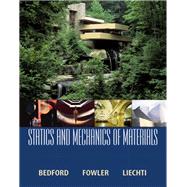
Note: Supplemental materials are not guaranteed with Rental or Used book purchases.
Purchase Benefits
Looking to rent a book? Rent Statics and Mechanics of Materials [ISBN: 9780130285935] for the semester, quarter, and short term or search our site for other textbooks by Bedford, Anthony M.; Liechti, Kenneth M.; Fowler, Wallace. Renting a textbook can save you up to 90% from the cost of buying.
Anthony Bedford is Professor of Aerospace Engineering and Engineering Mechanics at the University of Texas at Austin. He received the B.S. degree from the University of Texas at Austin, the M.S. degree from the California Institute of Technology, and the Ph.D. degree from Rice University in 1967. He has industrial experience at Douglas Aircraft Company and at TRW, where he did structural dynamics and trajectory analyses for the Apollo program. He has been on the faculty of the University of Texas at Austin since 1968. He is a member of the University of Texas Academy of Distinguished Teachers and has received several teaching awards over the years.
Dr. Bedford's main professional activity has been education and research in engineering mechanics. He has been principal investigator on grants from the National Science Foundation and the Office of Naval Research, and from 1973 until 1983 was a consultant to Sandia National Laboratories, Albuquerque, New Mexico. His other books include Hamilton's Principle in Continuum Mechanics, Introduction to Elastic Wave Propagation (with D.S. Drumheller), and Mechanics of Materials (with K.M. Liechti).
Wallace T. Fowler holds the Paul D. and Betty Robertson Meek Professorship in Engineering in the Department of Aerospace Engineering and Engineering Mechanics at University of Texas at Austin. Dr. Fowler received the B.A., M.S., and Ph.D. degrees from the University of Texas at Austin, and has been on the faculty there since 1965. During the Fall of .1976, he was on the staff of the United States Air Force Test Pilot School, Edwards Air Force Base, California, and in 1981-1982 he was a visiting professor at the United States Air Force Academy. Since 1991 he has been Associate Director of the Texas Space Grant Consortium.
Dr. Fowler's areas of teaching and research are dynamics, orbital mechanics, and spacecraft mission design. He is author or coauthor of technical papers on trajectory optimization, attitude dynamics, and space mission planning and has also published papers on the theory and practice of engineering teaching. He has received numerous teaching awards including the Chancellor's Council Outstanding Teaching Award, the General Dynamics Teaching Excellence Award, the Halliburton Education Foundation Award of Excellence, the ASEE Fred Merryfield Design Award, and the AIAA-ASEE Distinguished Aerospace Educator Award. He is a member of the Academy of Distinguished Teachers at the University of Texas at Austin. He is a licensed professional engineer, a member of several technical societies, and a Fellow of both the American Institute of Aeronautics and Astronautics and the American Society for Engineering Education. In 2000-2001, he served as president of the American Society for Engineering Education.
Kenneth M. Liechti is a Professor of Aerospace Engineering and Engineering Mechanics at the University of Texas at Austin and holds the E. P. Schoch Professorship in Engineering. He received the B.Sc. degree in aeronautical engineering from Glascow University and the M.S. and Ph.D. degrees in aeronautics from the California Institute of Technology. He gained industrial experience at the Fort Worth Division of General Dynamics prior to joining the faculty of the University of Texas at Austin in 1982.
His primary areas of teaching and research are in the mechanics of materials and fracture mechanics. He is the author or coauthor of papers on interfacial fracture, fracture in adhesively bonded joints, and the nonlinear behavior of polymers. He has consulted on fracture problems with several companies.
Dr. Lieehti is a Fellow of the American Society of Mechanical Engineers and a member of the Society for Experimental Mechanics, the American Academy of Mechanics, and the Adhesion Society. He is an associate editor of the journal Experimental Mechanics, published by the Society for Experimental Mechanics.
The New copy of this book will include any supplemental materials advertised. Please check the title of the book to determine if it should include any access cards, study guides, lab manuals, CDs, etc.
The Used, Rental and eBook copies of this book are not guaranteed to include any supplemental materials. Typically, only the book itself is included. This is true even if the title states it includes any access cards, study guides, lab manuals, CDs, etc.